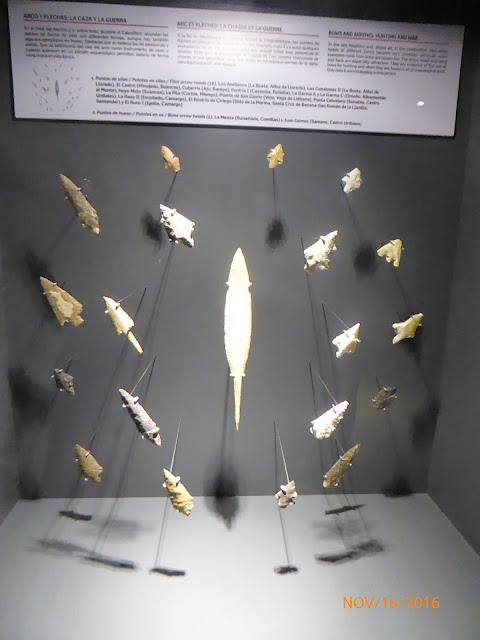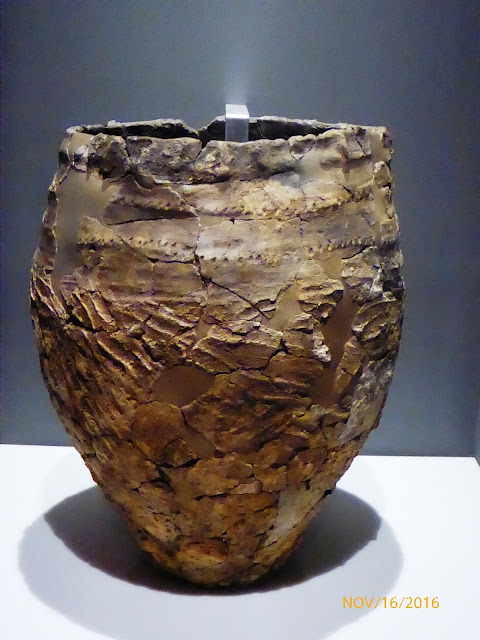As per our usual routine, we checked in at the train station, well before our usual departure time, checked our bags and wandered around the station till our train was available to us. Again (and I know you're secretly saying thank you) no pictures from the train. We arrived in Santander about 6:30 and walked to our hotel which was perfectly situated for this stage of the journey. We were one block from the train station, and one block from the maritime station where we would be departing the next day. It was another great little hotel, only about 37 rooms, in an older modernized building.
Train station from our room at night
Maritime station from our room at night
view of the station by day - note bus coming out from underground
buses going down underground
note the neat tiles on the wall of our 1913 hotel the Abba Santander
Motorcycles parked below our window - the Spanish are so constrained compared to the Italians - in Italy there would have been at least twice as many cycles parked in this space - some pointing in, some pointing out, some in front of and some behind the existing cycles, LOL!
Maritime station by day, lots of boats fishing on the bay
Our ferry did not leave till 6 PM, we couldn't board until 4:30, so we had all day to wander around Santander. It is a lovely little city in a very pretty location. There was lots to see just around our hotel.
In our wanderings we found the Prehistory and Archaeology Museum of Cantabria, so spent a couple of hours there. All the artifacts in the museum where found in the region. Apparently the area around Santander was one of the earliest inhabited places in Europe.
We first met our ancestors
About 1,000,000 years ago there was
Homo Antecessor
then about 250,000 years ago there was
Homo Heidelbergensis
followed by our last ancestor who died out about 30,000 years ago
Homo Neanderthalensis
various animals roamed the area
bear
rhino
buffalo
wild boar
coyote and wolf
carved bone spear heads
necklaces/collars
various vessels found in the region - it is thought that the different markings and ridges were used not only for decorative effect
but also as a way of defining ownership
but also as a way of defining ownership
metal spear heads
large iron pot
stele or standing stones were used as funerary markers
various bronze age artifacts
skull segment from a young woman who died violently about the 4th century BC, it is believed the hole in her skull was caused by a spear
Then the Romans arrived - in 26 BC Emperor Octavius Augustus
lead a campaign in the region
Roman tent pegs
tacks that were used in the soles of Roman legionaries sandals to
help improve grip and reduce wear
help improve grip and reduce wear
a broad sword
all Roman homes had a lararium or shrine with an altar and images of
gods that protected the household and it's occupants
this is young Neptune
this one young Hermes
for scale, the stone scarab is about 1 1/2 inches - the tiny spoons were thought to be for spooning incense into burners
gravemarkers
altars
said to be incense burners - note holes to let the smoke out - not
sure why they look more like pitchers with that pouring spout,
and if they would have had a cover
sure why they look more like pitchers with that pouring spout,
and if they would have had a cover
buckles from the time of the Visigoths
bone or ivory belt buckle dated to at least the 10th century - this was only about 3 inches in length total and was richly decorated with partridges, peacocks, leaves and geometric designs
Next we stopped for coffee and wandered thru the waterfront park.
this is the soup pot that was sitting outside the restaurant we went to. Everyone was given a small complimentary serving of this when they sat down - it was delicious. What I saw at this place too, was the servers giving complimentary food to elderly, disabled or disadvantaged people who came by and who they obviously had a relationship with - a sandwich to take home, an espresso, a large cup of soup. It made my heart feel good.
a monument to a local author
scenes on the monument depict popular stories from his books
a fine specimen of a palm tree flanked by rather large magnolia trees
then we met these handsome steeds
all part of this splendid two-tier carousel
this looked like a fun play structure, part trampoline, part slide,
part net climbing structure
interesting looking building, looks a bit space agey like a giant projector, and actually that is a big screen with the area in front of the building grassed with amphitheater seating
the building was even more interesting because of its
bubble wrap exterior
our ship is in
On Feb 15, 1941, extremely strong south and south-easterly winds battered the city. On Paseo de Pereda, gusts knocked trees over. Roofs, chimneys and drains were damaged by the force of the wind and pretty soon the streets were filled with dangerous debris – and a number of small fires broke out in the city. But the real trouble started at Number 20 on Calle Cadiz with a short circuit. The combination of the high winds and the old dry wooden structures of the buildings on the street meant the fire spread quickly from roof to roof and building to building. The fire in the Calle Cadiz spread south towards the port and north towards the higher part of the city.
The fire began late on Saturday 15 February 1941 and burned all day Sunday. The damage done by the blaze and the unfavourable weather conditions made communication to the rest of the region and country impossible until Sunday afternoon. Fire-fighting back-up eventually arrived on Sunday from Burgos at 7pm – followed by help from other neighbouring cities and Madrid later that evening.
In total 72,211 firemen battled the fire and its aftermath over 15 days. One of those firemen who came to help – Julian Sanchez from Madrid – lost his life when a building fell on top of him on Monday 17 February. Amazingly – it was the only life claimed by the fire. The wind calmed down on Monday afternoon which is when the flames were declared under control. 14 hectares of the city had been on fire.
In 40 hours, 376 buildings on 37 streets were burned to the ground. 1,883 apartments, 508 businesses, 155 bars & restaurants, 21 clinics, 2 public buildings, 6 churches and convents, 2 schools, 9 printing works and 3 newspapers were destroyed. Ten per cent of the city’s population – 10,000 people – were made homeless and 7,000 unemployed. The old city centre had been destroyed.
This 1913 building was in the middle of the flames yet somehow escaped unscathed. It is now the Abba Santander, the hotel we stayed in.

this series of statues commemorate the fire of 1941 and the lives lost











































































No comments:
Post a Comment